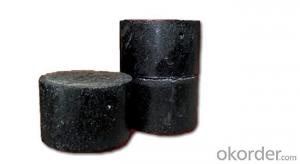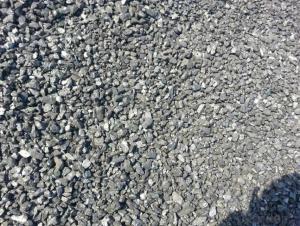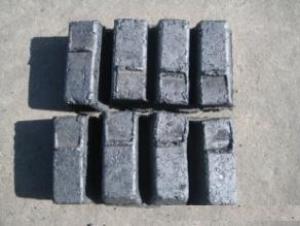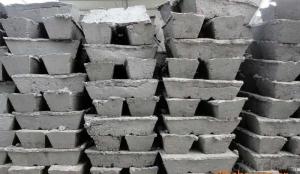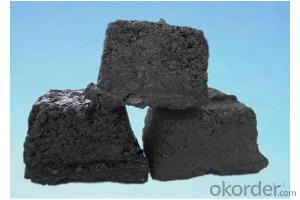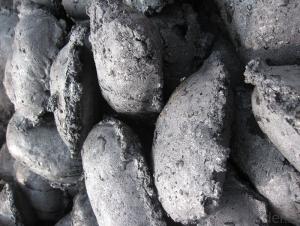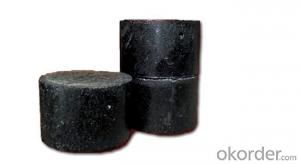cylinder Carbon Electrode Paste with low Ash
- Loading Port:
- Lianyungang
- Payment Terms:
- TT OR LC
- Min Order Qty:
- 20 m.t.
- Supply Capability:
- 800 m.t./month
OKorder Service Pledge
OKorder Financial Service
You Might Also Like
Spcifications
1:carbon eletrode paste
2:for ferroalloy,calcium carbide manufacture
3:HS 3801300000,YB/T5212-1996,ISO9001:2008
Product Description
Carbon Electrode Paste is a self-baking electrode used in submerged arc furnaces for delivering power to the charge mix. Electrode Paste is added to the top of the electrode column in either cylindrical or briquette form. As the paste moves down the electrode column the temperature increase causes the paste to melt and subsequently bake forming a block of electrically conductive carbon. Electrode Paste is essentially a mix of Electrically Calcined Anthracite (ECA) or Calcined Petroleum Coke (CPC) with Coal Tar Pitch.
Graphite/Carbon Electrode Paste Specification:
| PARAMETER UNIT GUARANTEE VALUE | ||||||
| Ash.( % ) | 4.0 max | 5.0 max | 6.0 max | 7.0 max | 9.0 max | 11.0 max |
| V.M (%) | 12.0-15.5 | 12.0-15.5 | 12.0-15.5 | 9.5-13.5 | 11.5-15.5 | 11.5-15.5 |
| Compress Strength. | 18.0 min | 17.0 min | 15.7 min | 19.6 min | 19.6 min | 19.6 min |
| Specific Resistance | 65 max | 68 max | 75 max | 80 max | 90 max | 90 max |
| Bulk Density | 1.38 min | 1.38 min | 1.38 min | 1.38 min | 1.38 min | 1.38 min |
Picture:
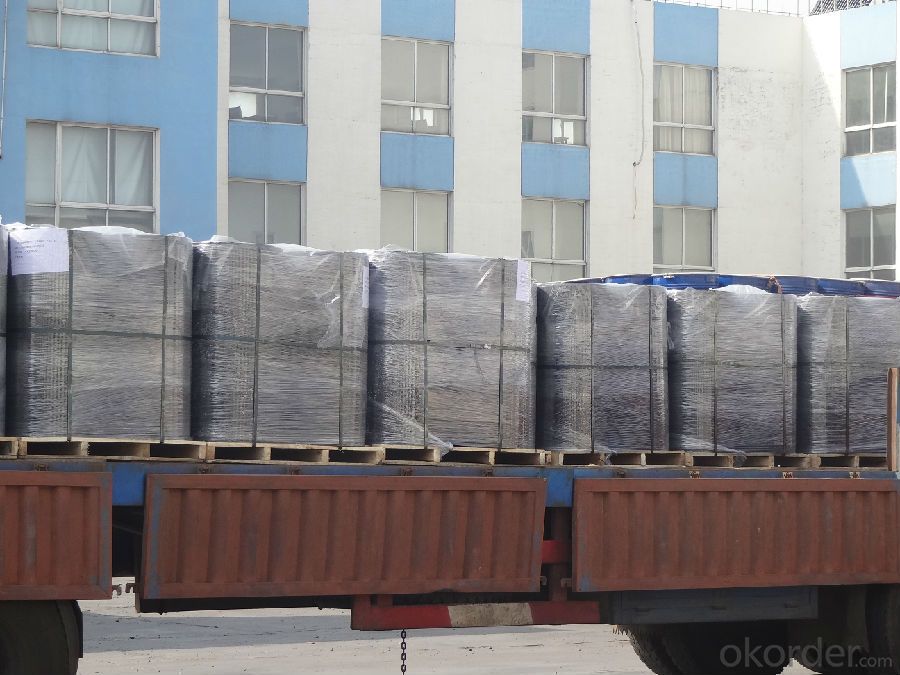
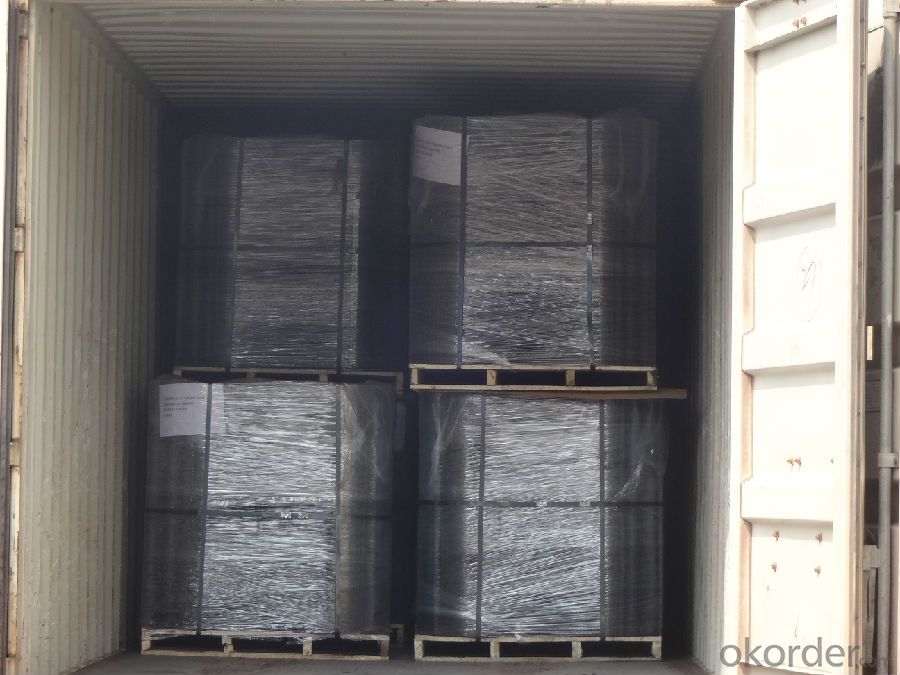
- Q: What are the effects of carbon emissions on the stability of ice shelves?
- Ice shelves are significantly affected by carbon emissions, which have a major impact on their stability. When carbon dioxide (CO2) and other greenhouse gases are released into the atmosphere, they trap heat and contribute to the phenomenon of global warming. This rise in global temperature leads to the melting of ice shelves and glaciers. One of the main consequences of carbon emissions on ice shelves is the acceleration of their melting rates. Higher atmospheric temperatures cause more ice to melt, resulting in a greater amount of water flowing into the ocean. This influx of freshwater can disturb the delicate equilibrium between the ice shelf and the ocean, potentially resulting in the collapse of the ice shelf. Furthermore, carbon emissions contribute to the thinning of ice shelves. As the atmosphere warms, the air temperature above the ice shelves increases, leading to increased surface melting. This meltwater then enters crevasses and cracks, causing further fracturing and weakening of the ice shelves. Over time, this thinning makes the ice shelves more vulnerable to breaking apart. The melting of ice shelves caused by carbon emissions also has indirect effects on the stability of surrounding ice sheets. Ice shelves act as a support, resisting the flow of ice from glaciers into the ocean. When ice shelves collapse or become thinner, this resistance decreases, allowing glaciers to flow more freely into the ocean. This process results in a rise in sea levels, which has significant implications for coastal regions worldwide. Moreover, the loss of ice shelves can disrupt the ecosystem and biodiversity of the surrounding areas. Ice shelves provide a platform for various species, such as seals and penguins, to breed and feed. When ice shelves disintegrate, these habitats are destroyed, impacting the entire food chain and the dynamics of the ecosystem. In conclusion, carbon emissions from human activities have a profound impact on the stability of ice shelves. The melting, thinning, and collapse of ice shelves contribute to the rise in sea levels, disrupt ecosystems, and have far-reaching consequences for coastal communities. It is crucial to reduce carbon emissions and take proactive measures to safeguard these vulnerable ice shelves and the delicate balance they uphold in our global climate system.
- Q: What are the effects of carbon emissions on the Earth's temperature?
- The Earth's temperature is significantly impacted by carbon emissions, particularly carbon dioxide (CO2), which is due to the greenhouse effect. The greenhouse effect is when certain gases in the Earth's atmosphere trap heat from the sun and prevent it from escaping into space, thus causing the planet to warm. When carbon emissions are released into the atmosphere, they act like a blanket, trapping more heat and making the greenhouse effect worse. This results in global temperatures increasing, commonly known as global warming. The main source of carbon emissions is the burning of fossil fuels such as coal, oil, and natural gas for energy production, transportation, and industrial processes. The accumulation of carbon dioxide and other greenhouse gases in the atmosphere has led to a steady rise in global temperatures over the past century. This temperature increase has various consequences for the Earth's climate system and ecosystems. One immediate impact of increased carbon emissions and global warming is the melting of polar ice caps and glaciers. As temperatures rise, ice melts at a faster rate, causing sea levels to rise. This poses a significant threat to coastal areas, with increased flooding and erosion potentially displacing communities and destroying habitats for different species. Moreover, global warming disrupts weather patterns, resulting in more frequent and severe extreme weather events. Heatwaves, droughts, hurricanes, and heavy rainfall become more common, causing damage to infrastructure, agriculture, and human health. Changes in precipitation patterns also affect water availability, potentially leading to water scarcity in certain regions. The Earth's temperature directly affects ecosystems and biodiversity. Many species are highly sensitive to even slight temperature changes, which can disrupt their natural habitats, alter migration patterns, and impact reproductive cycles. These changes can ultimately lead to the extinction of certain species and disrupt entire ecosystems. Furthermore, the warming of the Earth's temperature can have cascading effects on various natural processes. For example, it can cause the release of additional greenhouse gases from melting permafrost and the degradation of forests, further worsening global warming. In conclusion, the impact of carbon emissions on the Earth's temperature is significant and far-reaching. Global warming caused by increased carbon dioxide levels leads to the melting of ice caps, rising sea levels, extreme weather events, disruptions to ecosystems, and potential loss of biodiversity. Addressing carbon emissions and working towards sustainable practices are essential in mitigating these effects and ensuring a stable and livable planet for future generations.
- Q: What are the impacts of carbon emissions on the availability of freshwater resources?
- The availability of freshwater resources is significantly influenced by carbon emissions, which have a notable impact. One of the primary consequences is the alteration of the global climate system. Global warming is caused by the greenhouse effect, which is triggered by increased carbon emissions. Consequently, there is a rise in the Earth's temperature, resulting in changes in weather patterns and precipitation. These changes in weather patterns can disturb the water cycle, which crucially affects freshwater availability. Evaporation rates increase due to warmer temperatures, leading to a greater loss of water from lakes, rivers, and groundwater reservoirs. This, in turn, reduces the overall volume of available freshwater. Furthermore, global warming can worsen drought conditions in certain regions. As carbon emissions contribute to higher temperatures, the frequency and severity of droughts also increase. This further decreases freshwater availability, as there is limited precipitation and water sources become depleted. Carbon emissions also impact freshwater resources by affecting the melting of polar ice caps and glaciers. With the Earth warming, these frozen water sources melt at an accelerated rate, initially adding more freshwater to the global water system. However, once these ice sources are depleted, the loss of freshwater will be significant. Additionally, this process negatively affects the quality of freshwater resources as pollutants and contaminants from the melting ice can enter the water. Moreover, carbon emissions contribute to ocean acidification, which indirectly affects freshwater resources. The increased carbon dioxide in the atmosphere is absorbed by the oceans, leading to acidification. This change in the ocean's chemistry can harm marine ecosystems, including coral reefs, which are essential for maintaining the health of coastal freshwater sources like aquifers. To mitigate the impacts of carbon emissions on freshwater resources, it is crucial to reduce greenhouse gas emissions and transition towards cleaner and renewable energy sources. Additionally, the implementation of effective water management practices, such as conservation measures, efficient irrigation systems, and the protection of water sources, can help preserve and sustain freshwater resources in the face of climate change and carbon emissions.
- Q: How does carbon impact the prevalence of tsunamis?
- Carbon does not directly impact the prevalence of tsunamis. Tsunamis are primarily caused by seismic activity, such as earthquakes or volcanic eruptions, which are unrelated to carbon emissions. However, rising carbon levels can contribute to global climate change, leading to the melting of polar ice caps and potentially increasing the risk of coastal flooding, which can indirectly amplify the impact of a tsunami.
- Q: What are the advantages of carbon-based nanoelectronics?
- Carbon-based nanoelectronics offer several advantages over traditional silicon-based electronics. Firstly, carbon-based materials, such as nanotubes and graphene, have exceptional electrical properties. They can carry high electron mobility, meaning they can transport charges at a much higher speed than silicon. This allows for faster and more efficient electronic devices. Secondly, carbon-based nanoelectronics have excellent thermal properties. They can efficiently dissipate heat, reducing the risk of overheating in electronic devices. This is particularly beneficial for high-power applications, where heat management is crucial. Additionally, carbon-based nanoelectronics are extremely thin and flexible. Nanotubes and graphene can be easily manipulated to create ultra-thin and flexible electronic components. This enables the development of wearable electronics, flexible displays, and other innovative devices that were previously not possible with silicon-based technology. Carbon-based materials also have a higher mechanical strength compared to silicon. They are more resistant to bending or breaking, making them more durable and long-lasting. Furthermore, carbon-based nanoelectronics have the potential for scalability. They can be fabricated using various methods, including chemical vapor deposition and solution-based processes, which offer the possibility of large-scale production at lower costs. Lastly, carbon-based nanoelectronics are environmentally friendly. Carbon is an abundant element and does not pose the same environmental concerns as silicon, which requires energy-intensive processes for extraction and purification. Overall, carbon-based nanoelectronics offer improved electrical and thermal properties, flexibility, scalability, durability, and environmental sustainability. These advantages make them highly promising for the development of next-generation electronic devices.
- Q: What are the consequences of increased carbon emissions on forest ecosystems?
- Forest ecosystems experience significant consequences due to the increase in carbon emissions. One of the most notable effects is the modification of climate and weather patterns. The excessive presence of carbon dioxide in the atmosphere results in the retention of heat, leading to global warming. This rise in temperature can disrupt the delicate equilibrium of forest ecosystems. The warmer temperatures can cause shifts in the distribution and composition of tree species, as some may struggle to adapt to the changing conditions. Another outcome of the rise in carbon emissions is the acidification of rainwater. When carbon dioxide combines with water vapor, it creates carbonic acid, which can fall as acid rain. Acid rain has detrimental impacts on forest ecosystems, as it extracts vital nutrients from the soil and damages tree leaves and other vegetation. This weakens the overall health of the forest and makes it more susceptible to diseases and pests. Moreover, increased carbon emissions contribute to the intensification of wildfires. Higher temperatures and drier conditions provide an ideal environment for fires to spread and occur more frequently. Forests that have evolved to withstand natural fire patterns may struggle to cope with the increased intensity and frequency of these fires. This can result in the loss of biodiversity, destruction of habitat, and long-term degradation of forest ecosystems. Lastly, increased carbon emissions contribute to the phenomenon known as ocean acidification, where excess carbon dioxide is absorbed by the oceans. This acidification can impact the well-being of coastal and marine ecosystems, which are intricately connected to forest ecosystems. Many forest ecosystems, such as mangroves and salt marshes, serve as important nursery habitats for marine species. If these forest ecosystems decline due to carbon emissions, it can have cascading effects on the health and productivity of coastal and marine ecosystems. Overall, the increase in carbon emissions has wide-ranging consequences on forest ecosystems. It alters climate patterns, causes acid rain, intensifies wildfires, and affects coastal and marine ecosystems. These impacts not only harm the trees and vegetation within the forests but also disrupt the delicate balance of the entire ecosystem, resulting in the loss of biodiversity and long-term degradation. It is crucial to mitigate carbon emissions and promote sustainable practices to minimize these consequences and preserve the health and integrity of forest ecosystems.
- Q: What are the consequences of increased carbon emissions on public health systems?
- Increased carbon emissions have significant consequences on public health systems. One of the most prominent effects is the exacerbation of respiratory diseases such as asthma, chronic obstructive pulmonary disease (COPD), and bronchitis. Carbon emissions contribute to the production of fine particulate matter (PM2.5) and ground-level ozone, both of which can penetrate deep into the respiratory system and cause or worsen these conditions. Moreover, higher levels of carbon emissions are correlated with an increased prevalence of cardiovascular diseases. Fine particulate matter and other pollutants released from carbon-emitting sources can enter the bloodstream, leading to inflammation, oxidative stress, and the development of atherosclerosis. Over time, this can result in heart attacks, strokes, and other cardiovascular complications. Climate change, driven by carbon emissions, also impacts the spread of infectious diseases. Rising temperatures and altered precipitation patterns create favorable conditions for the expansion of disease vectors like mosquitoes and ticks, leading to the transmission of diseases such as malaria, dengue fever, Lyme disease, and Zika virus. Additionally, extreme weather events and natural disasters associated with climate change can disrupt healthcare infrastructure and compromise access to essential services, further impacting public health systems. Furthermore, mental health is also affected by increased carbon emissions. The environmental degradation caused by carbon emissions contributes to feelings of anxiety, stress, and depression, often referred to as eco-anxiety or climate grief. The loss of biodiversity, destruction of natural habitats, and the overall uncertainty surrounding the future can have detrimental effects on individuals and communities, requiring additional resources and support from public health systems. In summary, increased carbon emissions have far-reaching consequences on public health systems. They contribute to the prevalence of respiratory and cardiovascular diseases, facilitate the spread of infectious diseases, and impact mental health. Addressing carbon emissions and implementing sustainable practices are essential to mitigating these consequences and safeguarding the well-being of individuals and communities.
- Q: What is the structure of a diamond, a form of carbon?
- The structure of a diamond, a form of carbon, is a crystal lattice arrangement where each carbon atom is covalently bonded to four other carbon atoms in a tetrahedral arrangement. This gives rise to a three-dimensional network of carbon atoms with a repeating pattern. The bonds between the carbon atoms are extremely strong, resulting in the hardness and durability of diamonds. The arrangement of carbon atoms in a diamond forms a cubic crystal system, specifically the face-centered cubic (FCC) structure. This means that each carbon atom is surrounded by a total of eight neighboring carbon atoms, creating a dense and tightly packed structure. The strong covalent bonds and the compact arrangement of carbon atoms in the diamond lattice give rise to the unique properties of diamonds, such as their exceptional hardness, high thermal conductivity, and optical brilliance.
- Q: What are the effects of carbon dioxide on ocean acidity?
- Ocean acidity is significantly impacted by carbon dioxide (CO2), resulting in a phenomenon known as ocean acidification. When humans release CO2 into the atmosphere through activities like burning fossil fuels, the oceans absorb it. This absorption triggers chemical reactions that form carbonic acid, which lowers the pH of seawater. The increased concentration of carbonic acid in the oceans disrupts the delicate balance of carbonate ions, which are necessary for the formation of calcium carbonate. Numerous marine organisms, including coral reefs, shellfish, and plankton, rely on calcium carbonate to construct their shells and skeletons. As the ocean becomes more acidic, the concentration of carbonate ions decreases, making it increasingly challenging for these organisms to create and maintain their protective structures. Ocean acidification poses a significant threat to marine ecosystems and biodiversity. Coral reefs, for example, are particularly vulnerable to acidification. As acidity increases, corals struggle to build and maintain their calcium carbonate structures, resulting in bleaching and eventual death of the reefs. The loss of coral reefs has severe consequences for the countless species that depend on them for food, shelter, and reproduction. Additionally, other marine organisms such as shellfish and plankton are also affected by ocean acidification. Shellfish, including oysters, clams, and mussels, rely on calcium carbonate for their shells. As acidity rises, the availability of carbonate ions decreases, making it harder for these organisms to construct their protective shells. This can lead to reduced populations of shellfish, impacting not only the organisms themselves but also the industries and communities that rely on them economically and culturally. Plankton, the foundation of the marine food web, are also susceptible to the effects of increased ocean acidity. Many plankton species possess calcium carbonate structures that provide buoyancy and protection. As acidity rises, these structures weaken, making it more difficult for plankton to survive and reproduce. This disruption in the plankton community can have far-reaching consequences for the entire marine food chain, impacting fish, marine mammals, and ultimately, humans who rely on seafood as a primary source of protein. In conclusion, the impact of carbon dioxide on ocean acidity is significant and concerning. Ocean acidification jeopardizes the health and stability of marine ecosystems, affecting crucial organisms like coral reefs, shellfish, and plankton. Understanding and addressing this issue are crucial for the long-term health of our oceans and the countless species that depend on them.
- Q: Made of high strength structural partsThe market quality of the carbon fiber plate is too much, the price is low, do not know how to choose. A knowledgeable friend can introduce larger enterprises? The quality of the carbon fiber board produced must be better and the performance should be stable!
- You are not for the prestressing bar, if you find the building reinforcement for Tianjin Beijing card, if you do the structure reinforcement for Jiangsu and Wuxi via the new material industry, these are relatively well-known.
Send your message to us
cylinder Carbon Electrode Paste with low Ash
- Loading Port:
- Lianyungang
- Payment Terms:
- TT OR LC
- Min Order Qty:
- 20 m.t.
- Supply Capability:
- 800 m.t./month
OKorder Service Pledge
OKorder Financial Service
Similar products
Hot products
Hot Searches
Related keywords
